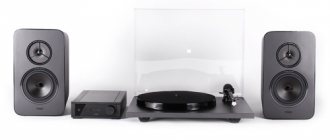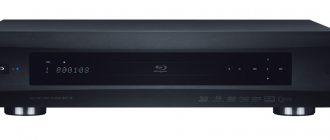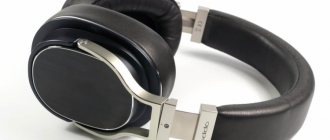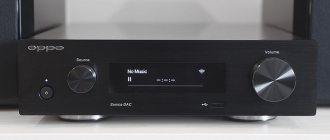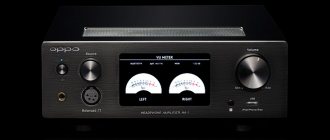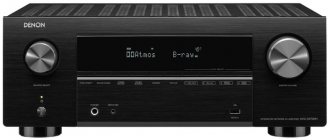OPPO BDP-103D 3D Blu-ray player review
Since the advent of the first high-quality media players, I have only used them to watch movies. I tried the “better build your own media player computer - it will be a completely universal option”, and I didn’t like it at all. A specialized media player, in my opinion, is much more convenient.
For the last year I have been using iconBIT XDS73D mk2 as a media player - a very good model, in my opinion, that reproduces well any common container codecs and even supports 3D. (However, this model also has certain disadvantages - like almost all other mid-range media players.)
iconBIT XDS73D mk2
I also have a good collection of Blu-ray discs with my favorite films, which I sometimes watch. I’m not ready to part with it yet, since I’m frankly too lazy to distill all these films into images for storage on hard drives.
Therefore, I had to buy a separate Blu-ray player. Well, since I don’t watch films on disc very often, I decided not to show off - and took something very, very budget: some Philips for either four or five thousand rubles.
The player, of course, turned out to be the most primitive, and all this was very, very inconvenient: when it suddenly occurred to me that I wanted to watch a movie on a BR disc, I had to plug the HDMI cable from the media player into the Blu-ray player, and this was very annoying.
Of course, neither the media player nor the Blu-ray player had any means of processing and improving the image.
At one time I thought that it might make sense to buy a high-quality Blu-ray player with good capabilities, but I was stopped by the fact that I had not met similar players that could at the same time fully perform the functions of media players: at that time they were all They were designed almost exclusively for playing Blu-ray discs, and even if they could play some media files from a USB-connected drive, this only applied to AVI with MPEG-4 - these players did not know any other formats like MKV.
However, Blu-ray players continued to evolve, and I was told that players appeared on the market that, in addition to playing discs, also provide a full range of media player functions, and also have interesting image processing capabilities.
Another thing is that such devices already belong to the high price segment, and I was not ready to buy a player for 60-70 thousand rubles just out of curiosity.
But then I was offered to test an advanced Blu-ray player from the manufacturer OPPO - model BDP-103D - and I, of course, agreed, because, judging by the specifications, this is exactly the device that interested me.
This player has many interesting features, but I don’t think it makes sense to list them all now; it’s better to look at all of them in detail in the review.
So, the OPPO BDP-103D 3D Blu-ray player is a Blu-ray player with full media player functions.
Specifications
CPU:
MediaTek Dual-Core
Video Processor:
Darbee
Memory:
1 GB
Network:
10/100/1000 LAN
Wi-Fi:
External USB 802.11n adapter (included)
Inputs:
HDMI Audio: Dolby Digital, Dolby Digital Plus, DTS, AAC , up to 5.1ch/192kHz or 7.1ch/96kHz PCM;
HDMI video: 480i/480p/576i/576p/720p/1080i/1080p/1080p24/1080p25/1080p30, 3D frame-packing 720p/1080p24; MHL audio: Dolby Digital, Dolby Digital Plus, DTS, up to 5.1ch/192 kHz PCM; MHL video: 480i/480p/576i/576p/720p/1080i/1080p24/1080p25/1080p30, 3D frame-packing 720p/1080p24 Outputs:
analog audio: 7.1 channel, 5.1 channel, stereo;
Coaxial/Optical: Dolby Digital, DTS, up to 2ch/192 kHz PCM; HDMI audio: Dolby Digital, Dolby Digital Plus, Dolby TrueHD, DTS, DTS-HD High Resolution and DTS-HD Master Audio, up to 7.1ch/192kHz PCM, up to 5.1ch DSD; HDMI video: 480i/480p/576i/576p/720p/1080i/1080p/1080p24/4Kx2K, 3D frame-packing 720p/1080p24 Disc types:
BD-Video, Blu-ray 3D, DVD-Video, DVD-Audio, AVCHD , SACD, CD, HDCD, Kodak Picture CD, CD-R/RW, DVD±R/RW, DVD±R DL, BD-R/RE
Video formats:
AVI, MKV, DIVX, XVID, MPEG, DAT, VOB, WMV , AVCHD, OGM, TS, MOV, MP4, FLV, 3GP, MTS, M2TS
Audio formats:
MP3, WMA, AAC, M4A, APE+CUE, FLAC, MKA, WAV, OGG, AIFF Lossless, ALAC Lossless
Image formats:
JPG, GIF+moving GIF, PNG, Picture CD, MPO 3D
Subtitle formats:
SRT, SUB, TXT, SMI, SSA, ASS, IDX+SUB, PGS
BR/DVD drive:
yes
Hard disk:
no
Dimensions:
430 × 311 × 79 mm
Weight:
7.6 kg
Price in Russia:
59,990 rub.
Contents of delivery
Supplied in a cardboard box, inside of which, between polypropylene foam inserts, there is the player itself in a special case-bag, a cardboard box with accessories and an instruction manual.
Inside the box: remote control with batteries, AC adapter, HDMI cable, USB Wi-Fi adapter, extension cable for USB adapter.
Appearance and features
The player is a classic black parallelepiped with dimensions tailored for installation in a rack with equipment.
Front panel: power button with indicator, information display, disc tray, tray release button, infrared sensor, USB port for external storage, HDMI input (supports MHL - Mobile High-Definition Link, a new interface used in some modern devices) , player control panel with five buttons.
The back of the player is especially interesting, because, in my opinion, I have never seen such a wide variety of interfaces in players.
So, from left to right: Ethernet port, HDMI input, special video output for diagnostics, coaxial audio output, optical audio output, HDMI1 output (support for 3D and special video signal processing technologies - more on this below), HDMI2 output (3D support), two USB 2.0, input for external IR port, RS-232C port, audio outputs 7.1CH/5.1CH/stereo, power adapter input.
Not a bad set, isn't it? Ability to connect up to three external drives (or two if using a Wi-Fi network, which is connected via a USB adapter). Support Gigabit wired network and wireless Wi-Fi network. Composite, optical and multi-channel analog audio outputs - to support older types of receivers that do not have HDMI ports.
The diagnostic video output is intended for situations where no signal is output on the TV (projector): for example, in a situation where the player is set to an unsupported resolution or frequency. In this case, connect the TV (projector) via an analog input - and you get a setup menu in which you can set the appropriate display parameters (automatic detection).
Two HDMI outputs are designed to output a signal to two different display devices - for example, a projector and a TV. And here you need to remember that HDMI1 supports a special video signal processing technology, while HDMI2 does not. But HDMI2, for example, can be used to output audio to a receiver that does not support HDMI pass-through.
The external IR port is used to connect an external IR sensor - for situations where, for example, the player is hidden in a closet: so that there are no failures when controlling from the remote control.
The USB Wi-Fi adapter extender serves the same purpose: so that the adapter can be placed in a place where the signal is more stable.
The control panel is large, convenient and backlit. Thank God, the manufacturers did not distort the shape of the remote control and made it in a completely traditional manner. (And then, you know, there are precedents for design delights in which it is completely impossible to use the remote control.)
Noteworthy are the separate buttons for calling the most popular services Netflix and VUDU, which will not work in Russia. I mean, the services will not work, not the buttons.
Device operation
By default, the player is configured to automatically detect the maximum resolution of the signal receiving device, so it does not have any connection problems: my two TVs and one projector to which I connected the player worked immediately without any questions.
The main desktop of the player is built in the classic style of desktops of modern advanced media players and game consoles: large icons for disc playback, music, photos, videos, network connections and settings.
Below them are icons of various Internet services.
A Blu-ray disc inserted into the player plays automatically (this can be disabled), and the speed at which it loads is simply amazing: it literally takes 3-5 seconds.
Of course, the full disc menu with all the additional materials and so on is available here. (Which is no longer possible when playing Blu-ray images and Blu-ray folders stored on hard drives.)
When playing a Blu-ray disc, you cannot jump to an arbitrary time mark, as media players do on videos, but all the standard means of rewinding films on Blu-ray are available: various types of acceleration, jumping by episode.
When you press the Option button on the control panel, a special menu appears at the bottom of the screen: disc information, subtitle settings (very advanced - both the position and parameters of the text change there, and, very importantly, the offset relative to the video stream), 3D mode (converting 2D to 3D , turning on 3D when playing stereo pairs), Zoom (display parameters), angle (shooting from another camera - this is extremely rare on discs), picture in picture (if the disc supports it, then some additional data may be displayed on the reduced picture), SAP (enabling playback of an audio stream from picture in picture).
Here is the Zoom setup mode. It can be changed directly during playback; the mode switches literally in 2-3 seconds.
I tried the other declared formats on the player. An ordinary DVD, an ordinary CD, all kinds of recorded and rewritable discs are played back without any problems.
All kinds of clips - matryoshka (MKV), AVI, MP4, TS, MOV, FLV with various codecs are also played back without any problems. Moreover, there is also a menu available there that appears by pressing the Option button. (But without some BR drive-specific features.)
However, I warn you that there are certain restrictions here that the developers were forced to do at the request of copyright holders. Therefore, in the basic package, playback of ISO images and Blu-ray folders from external sources is not available, and multizonality for Blu-ray and DVD is not implemented here.
Nevertheless, the issue can be resolved. All these features are available in alternative firmware for this player, which can be found on the Internet. Moreover, even if you install alternative firmware, the developer, as far as I understand, does not void the player’s warranty. (But it’s always better to check with the developer directly about such things.)
Now about the playback quality and all sorts of interesting effects.
Even without special processing, the playback quality of this player is clearly better than that of my simple Philips. No, it’s not 55 thousand rubles better, but this player is so much more expensive because of a whole range of very diverse functions, and not just because of the image quality.
But quality, of course, plays a significant role.
What's the difference? Unfortunately, for purely technical reasons, it is difficult for me to show this in a review so that it is clear, but in my own words, even when playing the picture without any processing at all, the image on this player had noticeably higher clarity and, accordingly, the picture received more small details and looked much better.
I observed a similar effect when comparing pictures from a Sigma DP2 Merrill camera and a full-frame Sony A9000 DSLR - these are 100% crops of the same scene.
This is roughly what it looked like on the screen.
And then there is a very advanced proprietary image processing engine called Darbee Visual.
Darbee Visual
This processing can be done while media content is playing using the Darbee Visual Presence video processor and Silicon Image VRS ClearView. I will not explain in detail what the essence of this technology is - you can read about it at the link.
And for me, as a consumer, what was more important was not how it all works, but what I get as a result, that is, how much the picture actually improves.
Darbee Visual processing, as I said, is only available for HDMI1 output.
This mode has three operating options:
- high resolution (for high quality media content);
- game (imitation of a video game);
- pop art (not very high-quality media content).
Each of these modes has numerous settings that are fun to experiment with.
And the result of this processing leads to increased image clarity, detail, clarity and depth. This is roughly what it looks like in the demo picture.
And it really works! Moreover, here you need to thoroughly study how certain modes work and play with their settings for each specific case: for example, when I output the same BR disc to a projector and to a TV, the pop art mode showed better results on my TV (it pulled out small details perfectly), and the high-resolution mode made the picture slightly unrealistic, as if you were watching a high-quality TV series (this is a well-known effect when improving the image, which appears on some modern advanced TVs); At the same time, it was the high-resolution mode on the projector that gave excellent results: the picture improved very noticeably, but did not look unrealistic.
Well, I tried old DVDs and low-resolution videos - yes, they also noticeably improved purely visually. It is clear that a miracle did not happen and some TV-resolution series did not turn into a BR disc, but the image looked much better, and this was clearly visible.
By the way, this technology can be used even when playing media content from some other device: the incoming HDMI port, which also supports MHL, is used for this purpose.
3D
The 3D mode of this player works without any problems, and it also supports vertical and horizontal stereo pairs (my media player does not support stereo pairs, as I was sadly convinced of a couple of times).
I tried the 2D to 3D conversion mode - well, it was only good as a toy, I didn’t like the result too much. However, this depends on the source material: for example, in cartoons this effect sometimes looked quite funny.
I also tried the upscale mode present here - that is, output, for example, FullHD resolution in 4K mode (for appropriate devices). I didn’t expect any miracles here; after all, when the original resolution is FullHD, stretching it to 4K gives practically nothing. (And this was a well-known joke of the old Sony PlayStation, which upscaled DVDs to FullHD: the quality of the stretched picture, of course, was practically no different from DVD resolution, but users really liked the opportunity itself.)
Here, simply by stretching the picture, the expected improvement in quality does not occur (purely visually), however, when you turn on various Darbee Visual modes, and also tinker with the settings, you get a small miracle: you get the feeling that you are really watching a 4K video. Of course, if you compare it with a full-fledged 4K video, the difference will be obvious (there are no miracles), but FullHD with processing and without stretching looked a little worse on a 4K TV than FullHD without stretching. (It’s a pity that photographs of the screens don’t convey this difference; there’s no point in posting them.)
Sound
The player supports a wide variety of audio formats, including several losless formats, where the audio stream is compressed without loss of quality.
Let me note that I don’t listen to music at all and my equipment is designed exclusively for video playback. Nevertheless, the equipment is quite good, so the sound quality can be assessed on it.
I tried different formats, including several types of losless (I specially compiled a collection for tests).
It sounds good. Even, in my opinion, excellent. But how to evaluate this purely technically - as far as I understand, there is no way. Therefore, we will be satisfied with my purely subjective “Sounds good. Even, in my opinion, excellent.” But in this case, in my opinion, it makes no sense to talk about frequencies and volume, because it depends on many factors: on the playback device, on the receiver, and on the speaker system.
I’ll be honest: at first I didn’t hear the warm tube sound. But then I took out an old tube amplifier from the closet (I still have one of those), heated it in the sun, put it next to it - and then I felt a warm tube sound, slightly smelling of dust.
Internet services
Unfortunately, most of the Internet services that are installed here are not supported in Russia.
But, for example, Youtube is supported.
The selection of services present in the player, with rare exceptions, is not suitable for Russia. Perhaps after some time there will be firmware that will do better with this matter.
Net
I tested playback over my home network. Wired network - no problems: the player sees all SAMBA servers, shows folders and media files, plays them up to 1080p format. (True, I have a gigabit network.)
Everything also works via Wi-Fi, but with known limitations on the channel width: a maximum of 720p videos were always transmitted through a wireless network without problems, but 1080p was already noticeably slowed down - here is a similar situation.
Everything was reproduced perfectly from external drives - also up to 1080p resolution.
Remote control
An interesting point - everything here is in step with the times. An application has been released for the player for different platforms OPPO MediaControl for BDP-10x, which allows you to use a smartphone or tablet as an extended control panel.
This is the application on Google Play.
View playback sources.
Folders of the connected external drive.
Playing a movie in MKV.
The control panel is displayed here in full, and it consists of three windows.
It all works well, I checked all the possibilities. It’s a very convenient thing; with it you don’t even have to look for the remote control: you take out your phone and here’s the remote control.
Observations during operation and conclusions
During testing, the player worked very stably: no freezes or sudden reboots. (And this often happens with media players.) I also didn’t find any other problems.
I really liked the player, despite the high price. In my opinion, this is exactly what you need for situations when your home theater uses high-quality equipment (receiver, audio system, television panel or projector) and requires a playback device to match it, that is, capable of delivering really good quality. The difference with cheap players is quite obvious here, and it’s very convenient that this Blu-ray player is also a very advanced media player.
But, of course, it’s clear that it doesn’t make sense to buy it if the speakers are a hundred-dollar set of “5.1 speakers” and some cheap TV - it won’t be good food for the horse.
Worth a closer look
It's quite difficult to repeat the success of previous models, and OPPO has done it twice in the last 3 years.
When they released their BDP-93 Blu-Ray player in 2011, the expectations of the vast majority of users were met. By offering a truly versatile all-in-one player, OPPO has gained a positive reputation. In terms of performance, functionality and build quality, Oppo's Blu-ray player hits the sweet spot. Oppo then released the BDP-103. This player has all the functions that were in the BDP-93 and added some more relevant ones: HDMI inputs/outputs, 4K upscaling, etc. OPPO also paid attention to the minor complaints that BDP-93 owners had and worked on the mistakes when designing the BDP-103.
BDP-93(top) and 103(bottom)
BDP-93(top) and 103(bottom) - rear panel
Continuing the success of previous models, Oppo has released the BDP-103D, which is essentially identical to the BDP-103 but with an upgraded video processor and Darbee image post-processing - hence the "D". Is this latest iteration of the BDP-103 a worthy successor or nothing more than a marketing gimmick? Let's find out...
Equipment, appearance and design of the device
We have already mentioned the appearance in the review. Frankly speaking, the BDP-103D does not have any special or atypical design for players. A classic black rectangle with a small OPPO logo and a tray for Blu-Ray discs on the front panel. After connecting the power, the matrix display lights up blue and the front panel comes to life. The device will look good in a rack next to other Hi-Fi or Hi-End components.
The device comes in a fairly large cardboard box, inside of which there is a fabric bag and a small cardboard box. The player is packed inside the bag, and in a small box there are accessories for it. The kit includes:
- Player
- Remote control and batteries for it
- USB extension cable and stand
- Wi-Fi USB adapter
- HDMI cable
- Power cable
- Manual in Russian
As you can see, there is not only everything you need, but also useful accessories in the form of a USB extension cable and a USB adapter for connecting to wireless networks. It is difficult to say for what purpose the manufacturer included the bag in the kit, but it can probably be used too.
Controls
The front panel, like the body, is made of metal. It contains the following controls:
- Illuminated power button
- Matrix screen
- Disc tray eject button
- Five buttons to control the player
In addition, on the front panel you can see a USB port, MHL/HDMI input, and an infrared sensor.
Note that there is MHL support – some mobile devices are equipped with this connector. Its feature compared to HDMI is the ability to simultaneously transmit content and charge a mobile device.
Despite the presence of control buttons on the front panel, to work with the BDP-103D it is better to use the included remote control. It is very convenient and allows you to quickly understand the basic settings and modes. The remote control runs on two AA batteries (they are included in the kit), and its buttons are illuminated in a pleasant white color.
Another control method is implemented using mobile applications. For smartphones equipped with an infrared port, free programs that replace the remote control are available in the Apple and Google stores. You just need to download and install the application, after which you can control the player from your smartphone.
Note that mobile programs are really convenient. All the main connectors are located on the rear panel, and we will talk about them in the next section.
conclusions
The BDP-103D is another outstanding Blu-ray player from Oppo! It combines excellent build quality and excellent performance. It's beautifully designed and built, with fast loading times, responsive navigation, and quiet operation. The menu is intuitive and easy to use. Wide switching capabilities and excellent audio playback when using the player as a transport. Video playback and upscaling to 4K at the highest level. The only difference between the BDP-103D and the previous BDP-103 is the addition of Darbee Visual Presence processing and VRS ClearView. Currently, OPPO Digital (https://www.oppodigital.com) is not discontinuing the BDP-103, which is $100 cheaper and can also be purchased on Amazon. But only BDP-103D is officially supplied to Russia with a warranty, service and technical support. So there is not much point in saving.
Architecture
OPPO UDP-203, like previous models, is designed very competently. The design is ideal: strict, laconic, devoid of embellishments, but at the same time it does not look rustic. The basis is the latest MediaTek OP8591 chipset. It is notable for the fact that it can decode not only 4K video with HDR10, but potentially also Dolby Vision, which is also going to be used on UHD BD discs and video files - the hardware of most other UHD players does not provide for such an upgrade.
To output digital signals, as before, two HDMI outputs are used: one universal version 2.0a and the second 1.4, respectively. This was done not so much for compatibility with outdated receivers and AV amplifiers, but rather in order to completely eliminate video switching by third-party devices (because even the newest of them somehow change the video signal, for example, lowering the bit rate from 12 to 10 or narrowing its dynamic range).
For the same reason, OPPO also provides an HDMI input in its players for other sources - game consoles or Smart TV dongles. Moreover, in this case, this input “passes” the signal practically unchanged, at least 12-bit video with 4K resolution “passes” through it.
It should also be said about the audio part of the player. Inside there is a high-quality Asahi Kasei AK4458VN DAC, the same one used by Marantz and Denon in their top receivers. Therefore, you can do without a receiver if you have separate final amplifiers that will receive the analog signal.


